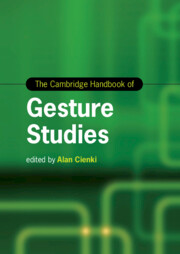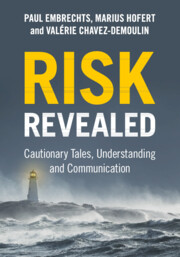784 results
1 - The Emoji Phenomenon Reviewed
-
- Book:
- Emoji in Higher Education
- Published online:
- 30 May 2024
- Print publication:
- 06 June 2024, pp 1-28
-
- Chapter
- Export citation
How are weeds named: A committee review of the WSSA composite list of names
-
- Journal:
- Weed Science / Accepted manuscript
- Published online by Cambridge University Press:
- 04 June 2024, pp. 1-31
-
- Article
- Export citation
CLIMATE-RELATED DISCUSSIONS ON SOCIAL MEDIA: CRITICAL LESSONS FOR POLICYMAKERS
-
- Journal:
- National Institute Economic Review ,
- Published online by Cambridge University Press:
- 04 June 2024, pp. 1-8
-
- Article
-
- You have access
- Open access
- HTML
- Export citation
Part II - Techniques
-
- Book:
- The Cambridge Companion to Composition
- Published online:
- 25 May 2024
- Print publication:
- 30 May 2024, pp 89-174
-
- Chapter
- Export citation
Introduction
-
- Book:
- Compelling Communication
- Published online:
- 30 May 2024
- Print publication:
- 30 May 2024, pp 1-4
-
- Chapter
- Export citation

Compelling Communication
- Writing, Public Speaking and Storytelling for Professional Success
-
- Published online:
- 30 May 2024
- Print publication:
- 30 May 2024
A Compelling Conclusion (Hopefully)
-
- Book:
- Compelling Communication
- Published online:
- 30 May 2024
- Print publication:
- 30 May 2024, pp 319-324
-
- Chapter
- Export citation
Medical record prompts improve the frequency and documentation of dizziness and driving conversations in the ENT balance clinic
-
- Journal:
- The Journal of Laryngology & Otology / Volume 138 / Issue S2 / June 2024
- Published online by Cambridge University Press:
- 23 May 2024, pp. S51-S55
- Print publication:
- June 2024
-
- Article
-
- You have access
- Open access
- HTML
- Export citation
Chapter 32 - Scenes from Postmodern Life: Literary Interventions in the Public Sphere
- from Part III - Literary Names
-
-
- Book:
- A History of Argentine Literature
- Published online:
- 09 May 2024
- Print publication:
- 16 May 2024, pp 507-519
-
- Chapter
- Export citation
Enhancing knowledge management in the engineering design process through a communication platform
-
- Journal:
- Proceedings of the Design Society / Volume 4 / May 2024
- Published online by Cambridge University Press:
- 16 May 2024, pp. 473-482
-
- Article
-
- You have access
- Open access
- Export citation
Research story telling: using the research journey map to communicate information, data, systems, and artifacts
-
- Journal:
- Proceedings of the Design Society / Volume 4 / May 2024
- Published online by Cambridge University Press:
- 16 May 2024, pp. 2337-2342
-
- Article
-
- You have access
- Open access
- Export citation
A global pilot comparative, cross-sectional study of clinical research nurses/research midwives: Definition, knowledge base, and communication skills related to the conduct of decentralized clinical trials
-
- Journal:
- Journal of Clinical and Translational Science / Volume 8 / Issue 1 / 2024
- Published online by Cambridge University Press:
- 06 May 2024, e90
-
- Article
-
- You have access
- Open access
- HTML
- Export citation
2 - What Is a Possible Human Language?
-
- Book:
- The Philosophy of Theoretical Linguistics
- Published online:
- 25 April 2024
- Print publication:
- 02 May 2024, pp 23-49
-
- Chapter
- Export citation
1 - Taking Your Skills to the Next Level
-
- Book:
- Navigating Communication with Seriously Ill Patients
- Published online:
- 05 April 2024
- Print publication:
- 25 April 2024, pp 1-14
-
- Chapter
- Export citation

The Cambridge Handbook of Gesture Studies
-
- Published online:
- 01 May 2024
- Print publication:
- 18 April 2024
Chapter 19 - Crowd-Related Considerations at Mass Gathering Events: Management, Safety, and Dynamics
-
-
- Book:
- Mass Gathering Medicine
- Published online:
- 11 April 2024
- Print publication:
- 18 April 2024, pp 268-283
-
- Chapter
- Export citation
Primary mode of communication for people with total laryngectomy in the UK: a cross-sectional survey
-
- Journal:
- The Journal of Laryngology & Otology , First View
- Published online by Cambridge University Press:
- 11 April 2024, pp. 1-6
-
- Article
-
- You have access
- Open access
- HTML
- Export citation
Exploring unmet concerns in home hospice cancer care: Perspectives of patients, informal caregivers, palliative care providers, and family physicians
-
- Journal:
- Palliative & Supportive Care , First View
- Published online by Cambridge University Press:
- 08 April 2024, pp. 1-9
-
- Article
- Export citation

Risk Revealed
- Cautionary Tales, Understanding and Communication
-
- Published online:
- 05 April 2024
- Print publication:
- 11 April 2024
Chapter 8 - Romanticism
- from Part II - Inspiration and Expression
-
-
- Book:
- Vaughan Williams in Context
- Published online:
- 28 March 2024
- Print publication:
- 04 April 2024, pp 70-77
-
- Chapter
- Export citation



